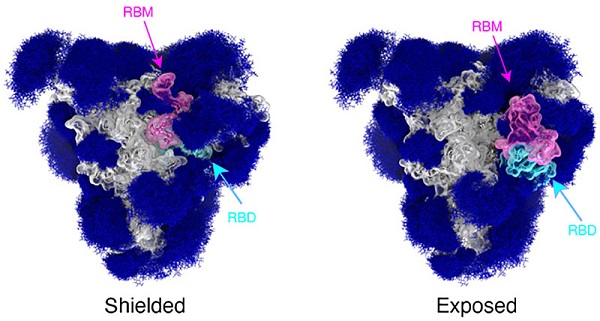
Simulations have revealed a gating function for the glycan molecules (dark blue) that cover the coronavirus spike protein (top view shown). COVID-19 infection starts with the opening of the receptor binding domain (RBD, cyan). Credit: Terra Sztain, Surl-Hee Ahn, Lorenzo Casalino (Amaro Lab, UC San Diego).
Despite more than a year and a half of research, there are still many unknowns about how the virus that causes COVID-19 infects human cells. A deeper understanding could lead to new treatment approaches. Using supercomputer simulations, a team from the University of California San Diego, the University of Pittsburgh, The University of Texas at Austin and elsewhere, have discovered how glycans—molecules that make up a sugary residue around the edges of the spike protein—act as “gates” that open to allow SARS-CoV-2 entry into human cells.
A study describing the results and a stunningly detailed movie of the process were published August 19 in the journal Nature Chemistry. The computationally intensive simulations were first run on the Comet system of the San Diego Supercomputer Center at UC San Diego and later on the Longhorn system at the Texas Advanced Computing Center (TACC) at UT Austin.
“We essentially figured out how the spike actually opens and infects,” said Rommie Amaro, a professor of chemistry and biochemistry and a senior author of the new study. “We’ve unlocked an important secret of the spike in how it infects cells. Without this gate the virus basically is rendered incapable of infection.”
Longhorn at TACC is an IBM graphics-processing-unit-based subsystem of the National Science Foundation-funded Frontera supercomputer. The researchers ran simulations of the coronavirus spike protein on 100 out of 448 of Longhorn’s NVIDIA V100 GPUs. The allocation was provided by the COVID-19 High Performance Computing Consortium.
“We were really happy with Longhorn. To get access to that many GPUs at once, it’s very powerful. You can do a lot of good science with that amount of compute power,” Amaro said.
Jason McLellan, an associate professor of molecular biosciences at UT Austin and his team created variants of the spike protein and tested to see how a lack of the glycan gate affected the RBD’s ability to open.

Rommie Amaro, professor of Chemistry and Biochemistry, University of California, San Diego.
“We showed that without this gate, the RBD of the spike protein can’t take the conformation it needs to infect cells,” McLellan said.
Amaro believes the research team’s gate discovery opens potential avenues for new therapeutics to counter SARS-CoV-2 infection. If glycan gates could be pharmacologically locked in the closed position, then the virus is effectively prevented from opening to allow entry and infection.
The spike’s coating of glycans helps deceive the human immune system since it comes across as nothing more than a sugary residue. Previous technologies that imaged these structures depicted glycans in static open or closed positions, which initially didn’t draw much interest from scientists.
Early in the pandemic, Amaro, a computational biophysical chemist, helped develop a detailed visualization of the SARS-CoV-2 spike protein that efficiently latches onto our cell receptors. The massive simulations were conducted in March of 2020 on TACC’s Frontera supercomputer.
Later simulations on Longhorn allowed the researchers to develop dynamic movies that revealed glycan gates activating from one position to another, offering an unprecedented piece of the infection story.
“We were actually able to watch the opening and closing,” said Amaro. “That’s one of the really cool things these simulations give you—the ability to see really detailed movies. When you watch them, you realize you’re seeing something that we otherwise would have ignored. You look at just the closed structure, and then you look at the open structure, and it doesn’t look like anything special. It’s only because we captured the movie of the whole process that you actually see it doing its thing.”
“Standard techniques would have required years to simulate this opening process, but with my lab’s ‘weighted ensemble’ advanced simulation tools, we were able to capture the process in only 45 days,” said Lillian Chong, co-senior author of the study at the University of Pittsburgh.

The Longhorn GPU subsystem of the Frontera supercomputer at TACC features an IBM POWER9-hosted system with 448 NVIDIA V100 GPUs.
The computing power available at UC San Diego and UT Austin provided the researchers with atomic-level views of the spike protein receptor binding domain, or RBD, from more than 300 perspectives. The investigations revealed gating position “N343” as the linchpin that pries the RBD from the “down” to “up” position to allow access to the host cell’s ACE2 receptor. The researchers describe the N343 glycan activation as similar to a “molecular crowbar” mechanism.
“TACC has been essential for our work since 2004, through allocations on the NSF-funded Extreme Science and Engineering Discovery Environment (XSEDE) for molecular dynamics research projects on bioengineering and cellular biology. And for COVID19, Frontera and Longhorn have been absolutely instrumental for our all-atom simulations of the SARS-CoV-2 spike protein leading up to the whole virion,” Rommie Amaro said.
The study was led by Amarro, Chong, UC San Diego graduate student Terra Sztain and UC San Diego postdoctoral scholar Surl-Hee Ann. Other authors include: Anthony Bogetti, Lorenzo Casalino, Jory Goldsmith, Evan Seitz, Ryan McCool, Fiona Kearns, Francisco Acosta-Reyes, Suvrajit Maji, Ghoncheh Mashayekhi, J. Andrew McCammon, Abbas Ourmazd, and Joachim Frank.
The research was funded by the National Science Foundation, the National Institutes of Health, the National Institute of General Medical Science, the RCSA Research Corp., and UC San Diego’s Moores Cancer Center.
source: TACC, which noted that this post was adapted from a press release by the University of California San Diego.



